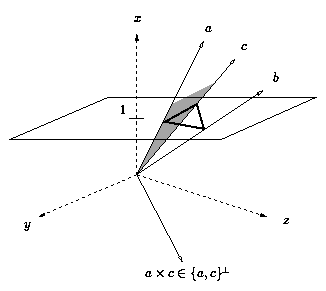This tutorial is probably also available as a Jupyter notebook in the demo folder in the polymake source and on github.
Different versions of this tutorial: latest release, release 4.13, release 4.12, release 4.11, release 4.10, release 4.9, release 4.8, release 4.7, release 4.6, release 4.5, release 4.4, release 4.3, release 4.2, release 4.1, release 4.0, release 3.6, nightly master
Coordinates for Polyhedra
This page explains how the coordinates for objects of type Polytope<Coord> in application polytope work.
Each polyhedron can be written as the Minkowski sum of a convex polytope (spanned by points $a, b, c,...$) and a cone (generated by the rays $r, s, t,...$). If the polyhedron is bounded, i.e. it is a polytope, then the cone is empty.
Suppose our polyhedron lives in a $d$-space $V$.
In order to obtain a unified view on the polytope and the cone section of a polyhedron, we embed $V$ as an affine subspace of a $(d+1)$-space $W$ such that the image of $V$ contains the point $(1,0,0,...,0)$ and it is parallel to the subspace spanned by the last $d$ unit vectors.
Points from both sections can now be identified with infinite rays through the origin in $W$. Facets are identified with the a hyperplane containing the image of the facet in $V$ and the origin in $W$. This hyperplane is represented by a normal vector.
Note that a facet defining hyperplane is not uniquely determined if the polyhedron is not full-dimensional.

A vertex is incident with a facet if and only if the scalar product of their representatives in $W$ is zero.
The polytope point $a=(ay,az)$ is modelled as the infinite ray from the origin $(0,0,0)$ through the point $(1,ay,az)$, i.e. the set of all non-negative multiples of $(1,ay,az)$. The cone point $r=(ry,rz)$ becomes the ray through $(0,ry,rz)$.
The facet containing the points $a$ and $c$ is represented by an (oriented) normal vector of the (hyper-)plane spanned by $a$, $c$, and the origin. If $d=2$, as in the picture, the normal vector can be computed as the cross product of $a$ and $c$. The normal vector will be oriented such that it points towards the interior of the polyhedron.
According to this model two points in $W$ are identical to polymake if they differ by a positive multiple. In particular, for a polytope point in the input data it is not required that the first coordinate is 1; it just has to be some positive number.
Notice, that by definition the combinatorics (encoded as VERTICES_IN_FACETS) of an arbitrary polyhedron is the combinatorics of a polytope which is projectively equivalent to quotient of the orginal polyhedron modulo its lineality space.
An example
The following defines the positive orthant in 3-space. It has only one vertex, the origin, and three rays pointing into the three coordinate directions. The distinction between these comes from our choice of the homogenizing coordinate.
> $p=new Polytope(POINTS=>[[1,0,0,0],[0,1,0,0],[0,0,1,0],[0,0,0,1]]);
This lists the facet coordinates.
> print $p->FACETS; 1 0 0 0 0 1 0 0 0 0 1 0 0 0 0 1
Each line describes one linear inequality. The encoding is as follows: $(a_0,a_1,...,a_d)$ is the inequality $a_0 + a_1 x_1 + ... + a_d x_d \ge 0$. This way a point in (oriented) homogeneous coordinates satisfies an inequality if and only if the scalar product of the point with the inequality gives a non-negative value. (Use the command print_constraints($m) to display the inequalities of the matrix $m in a nice way.)
Clearly, the polyhedron is unbounded.
> print $p->BOUNDED; false
Yet, the combinatorial data describe a 3-simplex.
> print $p->VERTICES_IN_FACETS; {1 2 3} {0 2 3} {0 1 3} {0 1 2}
The rays span the face at infinity.
> print $p->FAR_FACE; {1 2 3}
By the way, unbounded polyhedra can be visualized just like bounded ones. polymake automatically chooses a bounding box.
> $p->VISUAL;
Internal treatment of polytope generators
As described above polyhedra in polymake are modelled as the intersection of a cone with the affine hyperplane defined by $x_0=1$. Hence, infinitely many cones give rise to the same polytope. The algorithms in polymake usually work with the homogenized cone homog(P) of a polyhedron. Hence, polymake takes care about the correct canonicalization of user input of polytope generators in the following way:
In order to construct homog(P), the cone defining the polyhedron is intersected with the hyperplane $H_0: x_0=0$. The rays defining the bounded part $(R_b)$ and rays with $x_0=0$ $(R_0)$ are just inherited. To obtain the rest of the generators for the unbounded part, it is necessary to carry out a “dual Fourier-Motzkin procedure”: Any two rays with different signs are linearly combined to a new ray that is contained in $H_0$. All these rays together with the rays in $R_b$ and $R_0$ then define the homogenized cone homog(P).
Other coefficients
polymake has limited support for other ordered fields for coefficients of polytopes (and linear programs). An example are quadratic extensions to the rationals. As an example we show how to construct a regular triangle.
> $t=new QuadraticExtension(0,1/2,3);
This gives the number $ \sqrt{3}/2 $. More generally, you can construct the value $ a+b\sqrt{r} $ via QuadraticExtension(a, b, r). Note that currently polymake is restricted to computing with single extensions, i.e., you cannot mix distinct square roots.
> print $t*$t; 3/4 > $triangle = new Polytope<QuadraticExtension>(POINTS=>[[1,0,1],[1,$t,-1/2],[1,-$t,-1/2]]);
That regular triangle can be treated like any polytope. The following computes the area, which results in $ \frac{3}{4}\sqrt{3} $.
> print $triangle->VOLUME; 0+3/4r3